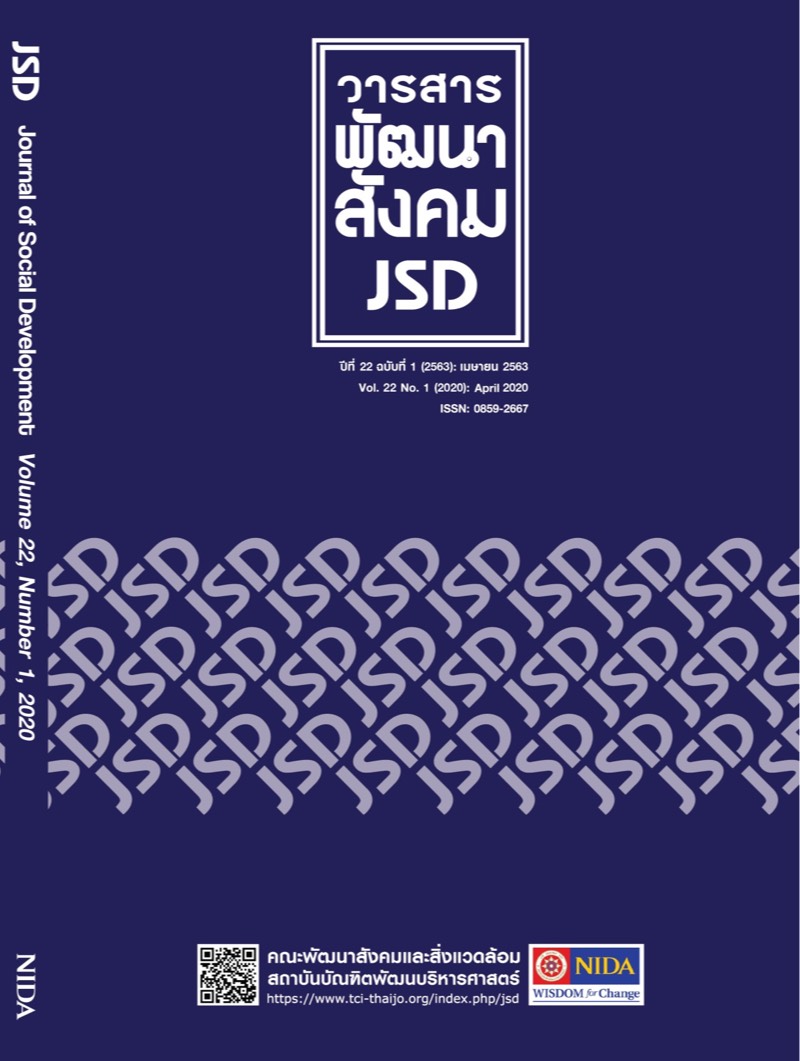การเปรียบเทียบการจัดการทรัพยากรน้ำของชุมชน จำแนกตามพื้นที่ลุ่มน้ำน่าน
Main Article Content
บทคัดย่อ
Article Details
เอกสารอ้างอิง
Allan, J. A. (2003) “IWRM/IWRAM: a new sanctioned discourse?” Occasional Paper 50, SOAS Water Issue Study Group. Retrieved February, 9, 2018. from: http:// www. soas.ac.uk/water issues as an Occasional Paper 50.
Boulware, E. W. B. (2013). Alternative Water Sources and Wastewater Management. The McGraw-Hill Companies, Inc. pp. 1-10.
Chankaew, K. (1996). Principles of watershed management (In Thai). Bangkok: Kasetsart University.
Chuenchooklin, S. et al. (2013). The project "Water resources management at the sub-basin and sub-basin community level Of the Nan River" (In Thai). Thailand Research Fund (TRF).
Department of Water Resources. (2015). Water resource management strategy (In Thai).
Department of Mineral Resources. (2009). District classification for geological and mineral resources management in Uttaradit Province (In Thai).
Department of Mineral Resources. (2009). District classification for geological management and mineral resources in Phitsanulok Province (In Thai).
Department of Water Resources. (2008). Water Resources Management Strategy 2015-2026 (In Thai).
Ferguson, G. F. (1976). Statistical analysis in psychology and education. (4 th ed). Tokyo : McGraw-Hill. Kogakusha.
Hydro and Agro Informatics Institute. (2012). Compilation operation Data and data analysis of the project for the development of a data warehouse system 25 watershed and drought water flooding model (In Thai). Asdecon Corporation Co., Ltd.
Jumsai, S. (1996). Naga: Cultural origins in Siam and the West Pacific. Oxford: oxford University Press.
Jukon, N. (2010). Strengthening the watershed committee case study: Yom Watershed Committee (In Thai) Department of Water Resources.
Kraft, M. E. (2018). Environmental Policy and Politics. University of Wisconsin-Green Bay.
Koonthanakulwong, S. et al. (2012). Project "Water Resources Study for Water Management of Nan River Basin Strategic" (In Thai). engineering Chulalongkorn University.
Land Development Department. (2002). Contour Line (In Thai).
Lethimaki, H. (2016). The Strategically Networked Organization: Leveraging Social Networks to Improve Organizational Performance. University of Eastern Finland, Kuopio, Finland.
Ministry of industry. (2017). Strategic Plan for Industrial Development in Nan Province, 2016-2021 (In Thai).
Mostert, E. (2006). Integrated Water Resources Management in The Netherlands: How Concepts Function. RBA Centre, Delft University of Technology, The Netherlands.
Noiva, K., Fernandez, J. E., & Wescoat, J. L. (2016). Cluster analysis of urban water supply and demand: Toward large-scale comparative sustainability planning, 27, 484-496.
Office of the Royal Development Projects Board (ORDPB.), (2004).
Office of the National Economic and Social Development Council. (2012). National Economic and Social Development Plan No. 11 (In Thai).
Patton, M. Q. (2002). Qualitative Research & Evaluation Methods. Sage Publications, Inc.
Prasitrathasin, S. (2012). Research Methodology in Social Sciences. (In Thai) Bangkok.
Prime Minister’s office. (2016). Draft national strategy for 20 years. (2017 - 2036). (In Thai).
Pharino, C. (2007). Sustainable Water Quality Management Policy. The Role of Trading: The U.S. Experience. MIT, Cambridge, MA, U.S.A.
Porter, J. R. & Howell, F. M. (2012) Geographical Sociology: Theoretical Foundations and Methodological Applications in the Sociology of Location. Springer Dordrecht Heidelberg London New York.
Rakyutiharm, A. (2000). Villagers network Resource management in the watershed by public participation (In Thai).
Royal Irrigation Department. (2014). Watershed data preparation project under irrigation development plan (In Thai).
Rea, L. M. and Parker R. A., (1997). Designing and conducting survey research: a comprehensive guide. Jossey-Bass Publishers.
Rosenberg, M. (2017). Strategy and Geopolitics: Understanding Global Complexity in a Turbulent World. Emerald Publishing Limited.
Ruengchan, P. (2016). Solving Flooding in Phitsanulok Province: Bangrakam Model (In Thai). Phitsanulok.
Takeuchi, Y. et al., (2010), Chapter 2 Community-based water management practices in Japan, in Rajib Shaw, Danai Thaitakoo (ed.) Water Communities (Community, Environment and Disaster Risk Management, Volume 2) Emerald Group Publishing Limited, pp.15 - 33.
Tirkanan, S. (2007). Research Methods in the Social Sciences: A Practical Approach (In Thai). Bangkok: Chulalongkorn University.
Zandaryaa, S. (2014). Water in the post-2015 development agenda and sustainable development goals. Division of Water Sciences - International Hydrological Programme (IHP), UNESCO. pp. 1-10.


